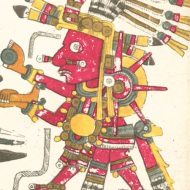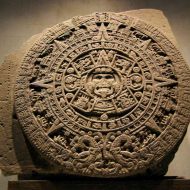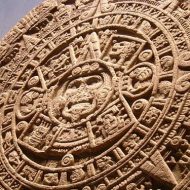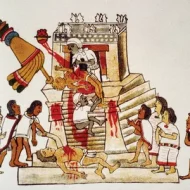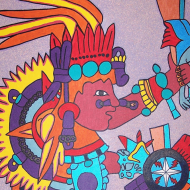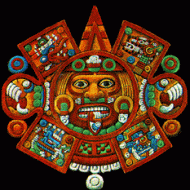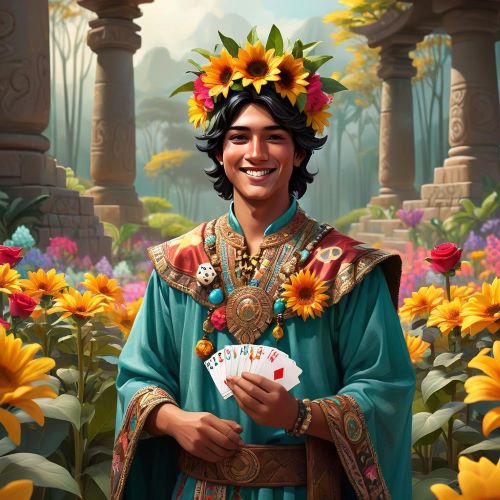Tonatiuh : The Sun God
Listen
At a glance
| Description | |
|---|---|
| Origin | Aztec Mythology |
| Classification | Demigods |
| Family Members | Nanahuatzin (Father) |
| Region | Mexico |
| Associated With | Sun |
Tonatiuh
Introduction
Tonatiuh, the sun deity in Mesoamerican religion, represents the fifth and final era known as the Fifth Sun. According to the myths of the Nahua peoples in Mesoamerica, including the Aztecs, Tonatiuh’s era followed four previous eras, all of which ended in catastrophic destruction. Tonatiuh, also known as Ollin Tonatiuh, is closely associated with the eagle during sunrise and sunset, and in Aztec beliefs, he is linked to the deity Huitzilopochtli. The Aztecs revered Tonatiuh as a god who faced constant threats due to the immense responsibilities of being born at sunrise, dying each sunset, and making his daily journey across the sky.
As per Aztec traditions, the gods themselves practiced voluntary sacrifice, first to create Tonatiuh and then to nourish him and support him on his celestial path. The worship of Tonatiuh involved militaristic cults and the frequent practice of human sacrifice to provide the necessary sustenance of human blood and hearts, thus ensuring the continuity of the world.
Physical Traits
Tonatiuh’s physical appearance in iconography serves as a visual representation of his function as a sun deity. In various depictions, Tonatiuh is portrayed wearing an eagle feather headdress and painted red, holding a shield that resembles a solar disc. Tonatiuh’s association with the sun is related to the belief that the eagle symbolizes the capturing of a person’s heart or life force through its ascending and descending talons. This symbolism is directly linked to the ritual of human sacrifice, which was connected to Tonatiuh and his consumption of the hearts of his victims.
Family
Tonatiuh’s origins were unconventional as he was brought into existence through the sacrifice of the god Nanahuatzin. This meant that Tonatiuh did not have the typical parentage and familial relationships. While some interpretations suggest that Nanahuatzin was not completely destroyed but rather underwent a transformation, other interpretations propose that Tonatiuh was either Nanahuatzin himself or closely connected to him. Interestingly, Nanahuatzin and the god Xolotl were closely associated with each other, to the extent that they could possibly be seen as different manifestations of the same deity.
Other names
The name Tōnatiuh originates from the Nahuatl words “tona” meaning “for there to be heat” and “yauh” meaning “to go.” When combined, these words signify “it goes along emitting heat.” This term was used to refer to both the god Tonatiuh and the sun itself.
In the Aztec culture, gods and individuals were often known by multiple names. Tonatiuh was no exception. According to tradition, Aztec gods and individuals would be identified by the calendar name of their date of birth. Tonatiuh was said to have been created on naui olin, also known as “4-Movement.” This name was part of a prophecy foretelling that the current age would be destroyed by earthquakes.
Powers and Abilities
Tonatiuh’s power was fortified through the offering of human sacrifices, allowing him to consume their hearts, just as he had originally been nourished by the hearts of the gods. It was believed that the sun was swallowed by the earth-fertility goddess, Tlaltecuhtli, each night, only to be regurgitated the following morning by a toad-like monster. Sacrifices ensured Tonatiuh’s triumphant return and victory against Tlaltecuhtli and the forces of darkness.
Warriors were closely linked to Tonatiuh as it was their responsibility to provide a consistent supply of sacrificial victims for him. Furthermore, Tonatiuh guided the spirits of deceased warriors to the afterlife. Given the sun’s crucial role in maintaining the harmony of the cosmos and the Aztec ruler’s role as the chief warrior, Tonatiuh had his own sacrificial altar during coronation ceremonies. During times of immense hardship such as famine, droughts, and war, Tonatiuh would receive an extensive number of bloody sacrifices, solidifying the Aztecs’ infamous reputation.
Modern Day Influence
Apart from the reference to the famous Aztec sun disk of which Tonatiuh is a central part, there are no other major representations in modern pop culture as he is not as popular as the other Aztec gods from the pantheon.
Related Images
Frequently Asked Questions
What is lorem Ipsum?
I am text block. Click edit button to change this text. Lorem ipsum dolor sit amet, consectetur adipiscing elit. Ut elit tellus, luctus nec ullamcorper mattis, pulvinar dapibus leo.
What is lorem Ipsum?
I am text block. Click edit button to change this text. Lorem ipsum dolor sit amet, consectetur adipiscing elit. Ut elit tellus, luctus nec ullamcorper mattis, pulvinar dapibus leo.
What is lorem Ipsum?
I am text block. Click edit button to change this text. Lorem ipsum dolor sit amet, consectetur adipiscing elit. Ut elit tellus, luctus nec ullamcorper mattis, pulvinar dapibus leo.
What is lorem Ipsum?
I am text block. Click edit button to change this text. Lorem ipsum dolor sit amet, consectetur adipiscing elit. Ut elit tellus, luctus nec ullamcorper mattis, pulvinar dapibus leo.
What is lorem Ipsum?
I am text block. Click edit button to change this text. Lorem ipsum dolor sit amet, consectetur adipiscing elit. Ut elit tellus, luctus nec ullamcorper mattis, pulvinar dapibus leo.

